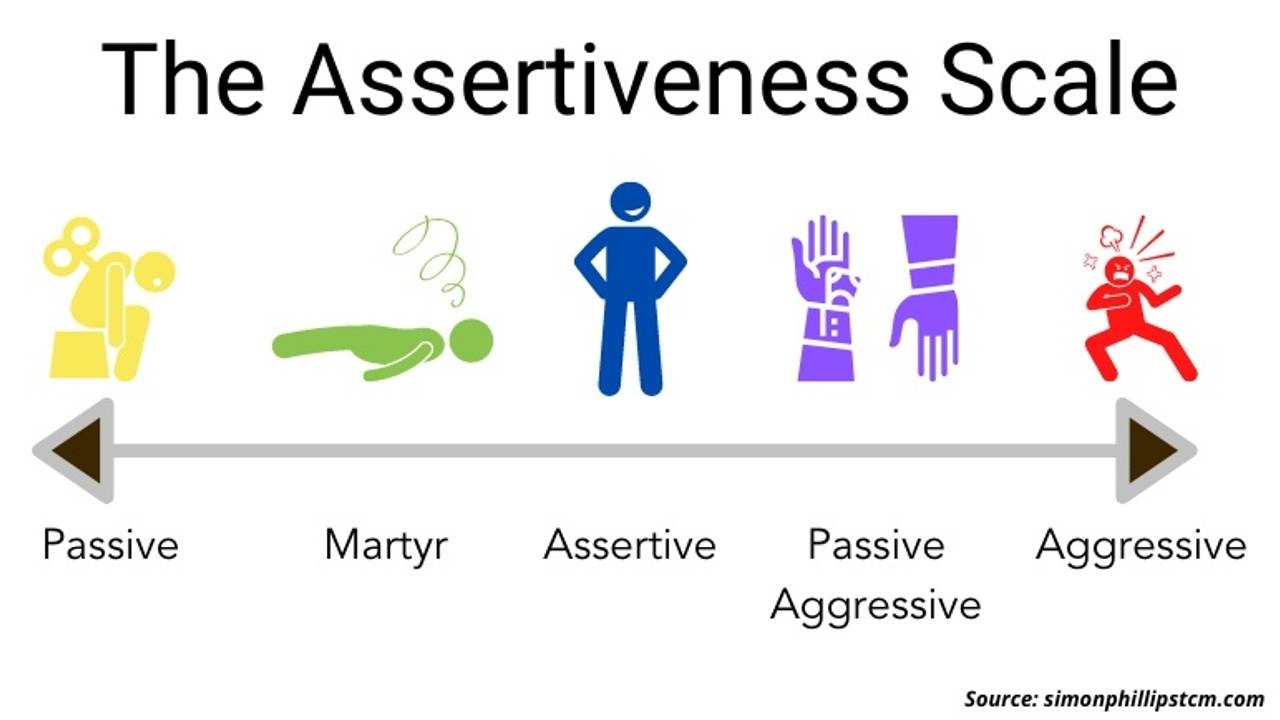Assertiveness: Where Are You On The Scale?
Feb 18, 2021
"Assertiveness: The only healthy communication style is assertive communication." - Jim Rohn
There is a scale that applies to our choices when it comes to communicating with others. It's a scale that determines the health of the conversations we have. It also affects the mental and emotional health of those involved. Us and Them.
Assertiveness at work is largely misunderstood and it is this misunderstanding that reveals itself on the Assertiveness Scale below.
Let's look at the basics first. The scale shows Aggressive at one end and Passive at the other. Assertive is right in the middle because it is neither passive nor aggressive. Instead, assertiveness is a willingness to contribute to a discussion without wishing to impose thoughts or feelings on others. We are open to opposing views, we are receptive to the idea that we may be wrong or misguided and we welcome the input of others. Equally, we are happy if our contribution is well received because it has helped move the thinking forward.
Aggressive communication seeks to impose itself on others. It is declaring "I am right". It can be seen to be saying ; "Your opinions do not matter". In this way, aggressive communication can intend to hinder or harm others.
Passive communication seeks to down-play the importance of what the individual is saying. It is saying, "I am probably wrong". It can also be seen to be saying, "My opinions do not matter". Consequently, passive communication can unintentionally cause harm the individual using it.
Intention Is key
However, there are other communication approaches on the scale. These are usually harmful and also unhelpful.
- Passive Aggression is still aggression. It is where people land when they want to assert themselves but they do so in a way that appears clumsy or spiteful. They deploy sarcasm or dark humour, often at the expense of the person they have decided is attacking them. The result of their actions is to hurt the other person even though this may not have been their intention.
- Martyrdom comes at the expense of the individual themselves. It is edging towards assertiveness but gives up trying, just before they could have made their point. It assumes it is easier to visibly sacrifice their own thoughts and feelings on the matter, than to express them clearly. Like passive aggression, martyrdom also seeks to intentionally harm their perceived opponents, even if it is only in making them feel bad.
A Change Maker has a desire to get the most from everyone and knows that this is only possible under two conditions:
- Everyone's motives, thoughts and feelings are clear.
- Intentions are pure and focused on seeking a win-win outcome.
As I assert in this week's video, being assertive boosts your effectiveness in the workplace because it underpins collaboration, which is essential if you are to get anything done!
Assertiveness is misunderstood
The reason why people end up being either passively aggressive or martyrs is because they misunderstand what Assertiveness is. Plain and simple, assertiveness means merely speaking your mind, but doing so in a way that takes care of everyone in the conversation. To feel how effective assertiveness can be in all areas of your life, it is useful to recognise that being assertive:
- Is not about trampling over others thoughts and feelings or ignoring your own.
- Is not about trying to prove others wrong or believing what we have to say is of no value.
- Is not about thinking others have more right to express themselves or that our voice is not strong enough to be heard.
These beliefs lead to the ineffective behaviours mentioned above.
Take every opportunity to speak up. You will find that others will welcome your contribution. It will also signal to others that their thoughts and feelings are important too.
If this has been of value and you would like to explore it more with me, just drop me a note.


